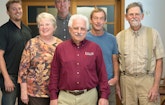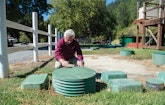
Peter Lescure inspects an aboveground Orenco Systems AX100 treatment system he specified for a riverside campground prone to flooding. He is pointing to a Wager flood-proof air intake he employs in systems built in flood zones.
At one time a traffic and transportation engineer, Peter Lescure did not deliberately set out to transition into serving the wastewater industry. But nearly 40 years into his onsite system design career, Lescure has played a role in helping modern wastewater technology take root in California’s Sonoma County wine country.
The career switch happened when Lescure contemplated ways to move from the congested San Francisco Bay Area in the 1960s. A friend in Sonoma County encouraged him to buy a backhoe and move north because backhoe operators were hard to find. For five years, from 1964 to 1969, Lescure had worked in construction and hired independent backhoe operators.
“I said, ‘Wow, I get to move to Sonoma County, and I get to play with a backhoe — what fun.’ And that was my entree to septic systems,” Lescure says. “So I bought a backhoe and a dump truck, moved to Sonoma County, and within the year the regional water board and the county said they would begin allowing engineered septic systems — Wisconsin mound systems. And they started requiring the site inspections to be done by licensed engineers.”
It was a perfect fit for Lescure. With the backhoe, he did site explorations during the day and wrote the engineering reports at night. “Then I’d go out and get the site surveyed and design the system, and then I’d build it,” he says.
At the same time, he was running a construction contracting business.
Engineered wastewater systems became more complex, and Lescure realized full-time engineering was to his advantage and gradually let go of contracting until, by about 1984, he was doing only engineering from Lescure Engineers in Santa Rosa. The benefits included investing less money in equipment and materials, and he no longer had teams of workers spread across multiple counties.
WHAT IS VESTING?
With his reputation for doing onsite work and his engineer’s background, Lescure became a resource for local officials. He helped Sonoma County write many of its onsite regulations. One that he is especially pleased with is the county’s vesting ordinance.
It grew from the frustrations of developers who prepared plans but then faced opinions and rules that had changed by the time they were ready to break ground or sell the lots. This was especially the case after one of the building industry’s cyclical slumps. What was good before a slump was not necessarily accepted by officials after it. Lescure was serving on a land use advisory committee at the time.
“And their regulations were a mess with bits and pieces of policy scattered all over. I said we needed to organize all of it and put it in a book,” he says.
Many of those regulation changes happened because Sonoma County was progressive in adopting new system types, bringing inevitable adjustments. The nearby counties of Napa, Marin and Mendocino struggled in the same way to update their policies.
Lescure introduced the concept of vesting, which is the ability to lock in development plans for a period of time. It is a protection for developers and allows them to delay projects for a year or two without then rewriting plans or ordering new tests.
For example, completed perc tests and site evaluations are valid for at least a year in Sonoma County. Once drawn up and approved, a wastewater site plan is valid for two years and can be renewed for another two years. A wastewater system in the ground before a building is constructed can be vested for three years.
BIG-PIPE ALTERNATIVES
His website says Lescure works on sustainability. It’s a trendy word, but in onsite work, it is a reality. “We kind of think that soil-based systems, septic systems, are more sustainable than the big-pipe things. Water stays local. You’re not putting big, expensive pipes in the ground that infiltrate and exfiltrate,” he says.
The reality is that stormwater flows into wastewater pipes through leaky joints, but the reverse is also true. When the water table drops, those same joints leak wastewater outward, and that may contaminate the groundwater.
“And sustainability means we’re always looking at the impacts we have, or as much as we can. It’s not a perfect world. You’re going to have an impact as soon as you step on the ground,” Lescure says.
As he watched the wastewater industry change, he also saw divisions fall away.
“There used to be a divergence — the big-pipe guys and the little-pipe guys. Thanks to George Tchobanoglous, finally the big-pipe guys are coming around to recognizing there are ways to do something other than conveying everything to a big central plant,” he says.
Tchobanoglous — a retired professor of engineering at the University of California, Davis — has literally written the books on water treatment. He helped break down barriers between people advocating for one wastewater solution over another.
His view that there are different and equally effective ways to handle wastewater will become important around Santa Rosa because of the regional water boards’ Russian River Pathogen TMDL plan, Lescure says. Along the river are many communities of what were second homes but are now the most affordable primary residences. The only affordable, environmentally acceptable wastewater solution for those homes will be decentralized treatment, Lescure says.
“You design what suits the need. These big companies that do wastewater are coming from the huge municipal end — New York and Milwaukee and San Francisco. Their tendency is to scale down what they already know. I come from the leachfield end, and my tendency is to scale up what I already know,” Lescure says.
WINERY WORK
Given its location, wineries became a natural specialty for Lescure Engineers. Sonoma County has a large number of vineyards, and next door is the perhaps more famous Napa Valley.
“One of my first winery jobs was when Sutter Home was bringing out their white zinfandel back in the ’80s,” he says. The winery needed a wastewater system, and the geotechnical engineer on the project referred them to Lescure.
Initially Lescure was the specialist whom other engineering firms turned to for onsite systems site evaluations and designs. He changed as the competition grew. “We’ve expanded from doing solely wastewater systems to the full range of civil engineering,” he says.
Another project was for Sonoma Wine Co., which bought an old apple processing plant and converted it to a winery. It was more of an energy and water conservation project, as it turned out.
“My staff and other consultants succeeded in reducing the amount of water they used per barrel of wine by half. So they were able to legally double their production capacity under their existing zoning permit. They went from a million and a half cases a year to 3 million without touching their wastewater system.”
Winery waste is a challenge because the flows and strength are highly variable. The first peak flow and loading occurs when grapes are being picked and crushed, from August to October. That is both volume and strength: a lot of water used in the process and a lot of organic material flowing into drains.
“Where a domestic septic tank effluent BOD might be 300 mg/L, we start designing wineries at 5,000 mg/L,” he says. “I remember when I did that Sutter Home winery, I measured 25,000 mg/L in a pump sump. One time I took a sample from one of the valve boxes on the mounds I designed for them, and it was 8,000 mg/L.”
The amount of wastewater per unit of wine varies greatly based on the practices at each winery, but annually and on average, 1 gallon of wine generates 4 to 6 gallons of wastewater, he says. About one-quarter to one-third of that wastewater is produced during the grape-crushing period.
The second peak comes in February when the first fermentation is complete and wine is decanted from stainless steel tanks and put in barrels for aging. “At the bottom of the tanks is all the dead yeast and all the other stuff that settled out, kind of like a clarifier in a wastewater plant,” Lescure says.
The third peak comes in June and July when wine is bottled. Wash water used to clean bottles, barrels and bottling equipment is cleaned each day.
For a long time, the favored wastewater solution for wineries was aerated lagoons. There would typically be one or two ponds in series for treatment and then a storage pond from which water would be drawn to irrigate the vineyards and landscape. But ponds require a fair amount of real estate and can be challenging to manage, Lescure says.
The challenge for any ATU used in the wine industry is the variability of the flow. ATUs have suspended growth, and if you don’t keep the bugs happy, they all die, Lescure says. In addition, winery waste is acidic and deficient in nitrogen. Both must be adjusted to keep treatment microorganisms alive.
He is intrigued by the work of Orenco Systems, which is putting an aerated storage tank in the treatment chain to reduce the biological load before wastewater enters an AdvanTex media tank.
“The other thing that just occurred to me recently was: So we’ve got this high variability in flow, right? What’s the answer to high variability? It’s called flow equalization. So you put in a big tank, and then you meter out of the tank into the treatment system. You have to have a tank anyway, so you just size it bigger,” he says.
CALLING ALL WORKERS
Labor changes are a continuing part of the business. Lescure lost an engineer not too long ago to a health issue, but he fortunately had been contacted by a former employee from about 30 years ago. That engineer was able to step in and handle a large project. A surveyor left, and Lescure was able to quickly find another.
The surveyor needed an assistant. A local guy joined the firm, but after a week, he realized his computer skills were too far out of date and at the same time a local winery offered him a job as a maintenance superintendent. Fortunately, a sharp high school graduate already accepted to engineering school at the University of California was in the office as an intern and stepped into the survey assistant’s job. Lescure was fortunate to replace him with a great survey tech from the program at Santa Rosa Junior College.
Lescure isn’t alone in his scramble to fill vacant positions.
“Everybody out here is just screaming for help. The construction industry is just screaming. We have 4 percent unemployment and 1 percent housing vacancy. Our median — median — house price in Sonoma County is $660,000.”
Lescure’s firm is getting work from San Francisco tech industry people helping drive those housing prices as they buy and build large second homes in the country north of San Francisco Bay. And recently the huge wildfires that burned through Northern California caused the largest property loss in the history of the state.
The homes that burned along the hills to Kenwood and Sonoma rely on septic systems, Lescure says. Fire damaged tank risers, above-ground treatment units, and electrical control panels. An older Larkfield subdivision also relies on septic systems. Estimates to connect them to municipal sewer range from $41,000 to $72,000 per lot. Lescure’s company is preparing a preliminary plan using septic tank effluent pump, or STEP, technology that will be about one-half the big-pipe cost.
His employees receive a good health plan through Kaiser Permanente, the big California provider, plus disability, dental care, and “compensated leave time.” This accrues at two to six weeks per year, depending on an employee’s time with the company. Employees may use the hours for vacation or sick time, their choice. It’s a policy that reduces administration time while giving employees more freedom.
PLENTY TO LEARN
Before the recession, Lescure thought about retiring. He is starting to think about it again. He’s hired a consultant to help with that and update his business plan.
His office has moved into 3D CAD software. Usually there is a learning curve with software, he says. At first productivity is low, but then it increases as you learn the tool.
“Now it’s like we’re constantly on the steep part of that learning curve. And they say, yeah, this software will make you a whole lot more productive. Sure, if they’d quit changing it every year,” he says.
And there are changes in products and changes in regulations. But if Lescure and his company have shown one quality during nearly 40 years in business, it is an ability to adapt.
Sustaining a great reputation
Lescure Engineers has a recognized name and good reputation, but founder Peter Lescure continues to market it. He belongs to local associations such as the chamber of commerce and advertises in a few specialty publications where he can reach attorneys, builders, and others who deal with land.
“Word-of-mouth, as in any industry, is always the best, so we try to do good work and hopefully get some referrals from the counties, our past clients, and our local real estate agents,” he says.
“When I came up here, each of the real estate offices had their sales meeting on a particular morning, and they had their land and farm groups, too, the people who specialize in rural lands. I would go and educate them about septic systems.
“And it really changed the culture. Back then, you could read the ads and there was no mention of septic systems, just ‘two bedrooms’ or ‘three bedrooms.’ Now the rural real estate ads have land description that mentions a perc test for a certain number of bedrooms, and it’s not just a perc test but a vested perc test,” he says.










